Introduction to Programming with Python
Erick Martins Ratamero
Research Fellow
Hello
@erickratamero
Acknowledgements
- Philo van Kemenade (@phivk) from whom I "stole" the general structure of the presentation and some of the images
- (original at https://slides.com/phivk/intro2python)
This Workshop
- Building blocks
- Putting the pieces together
- Writing complete structures
These Slides
tiny.cc/camdupython
Let's talk about Python
Talking Python
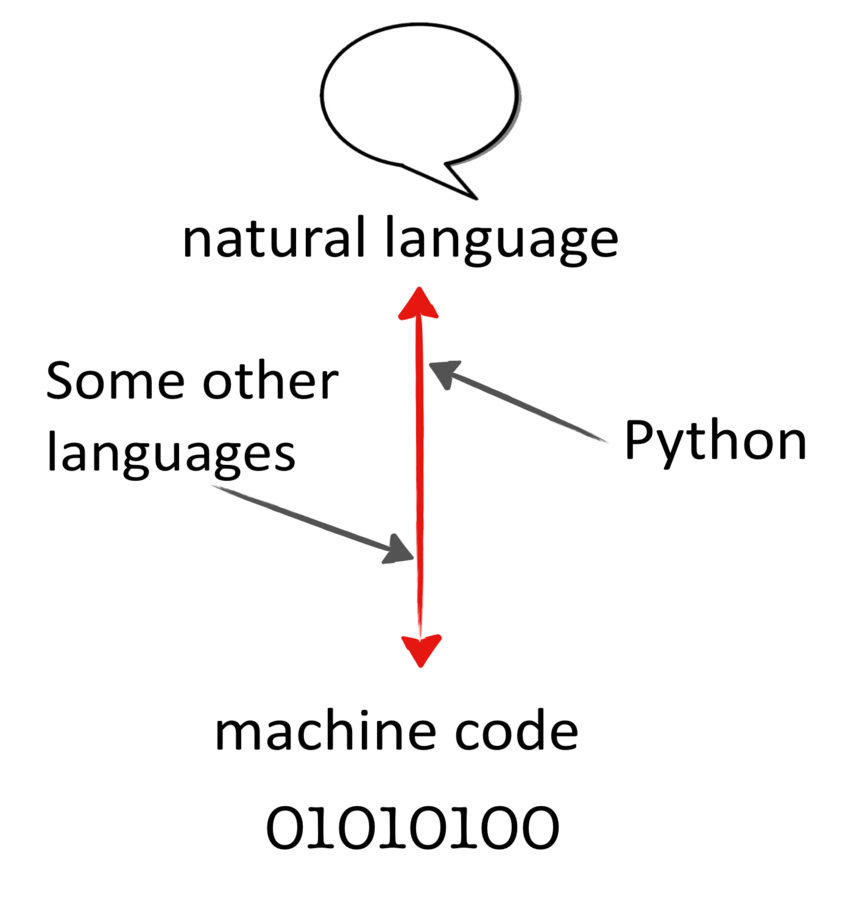
Two Modes of Operation
Scripting Mode
- Code in file
- Save & load programs
- More control
Interactive Mode
- Terminal-based
- Direct feedback
- Try out code
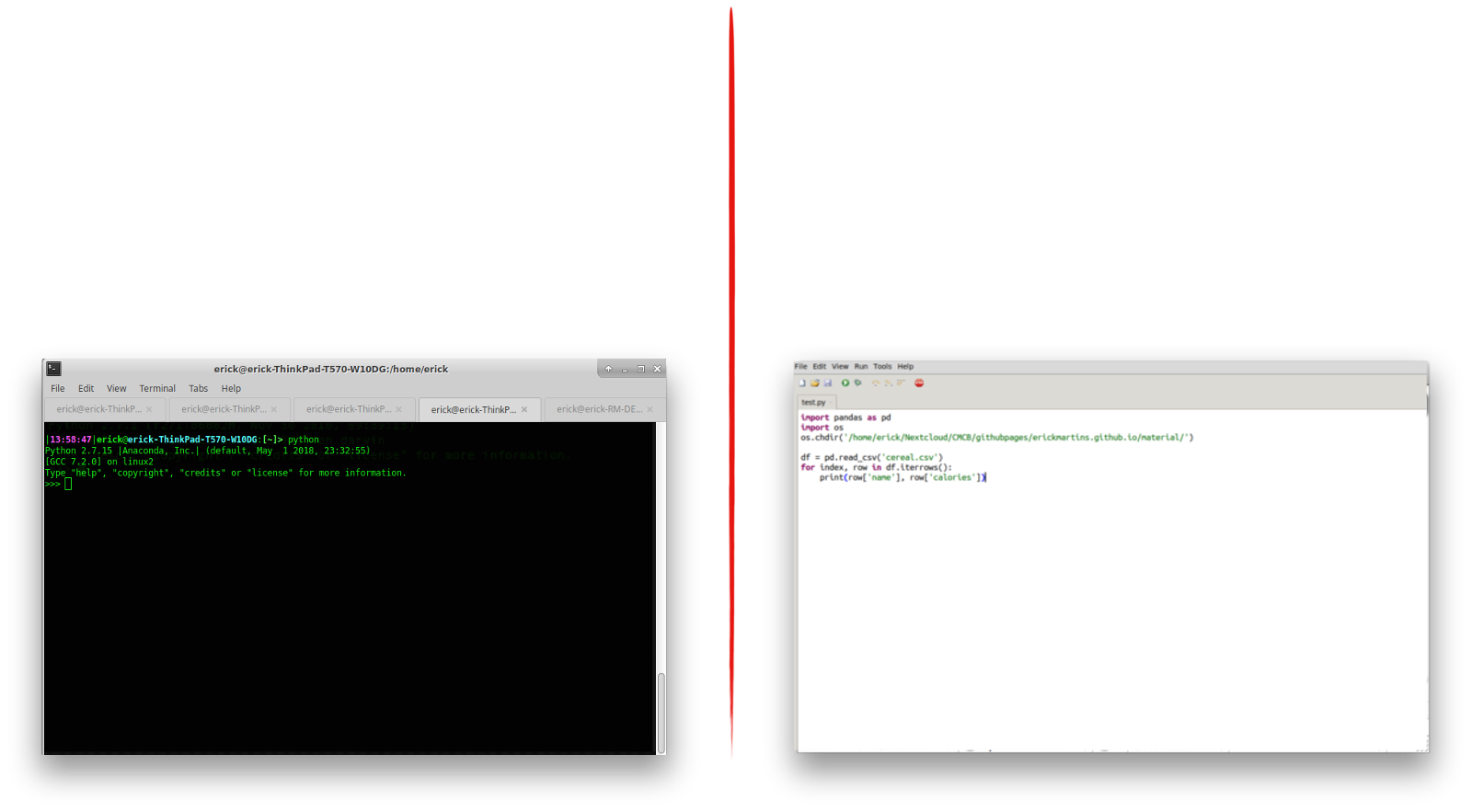
Setting Up
Download Thonny from https://thonny.org
Install Thonny
Done!
Getting help
help()(then Q for quit)
Documentation at docs.python.org/3
Just googling stuff is surprisingly helpful (and what everyone does)
Syntax
Some of it you already know

Python as a calculator
Building Blocks
VARIABLES
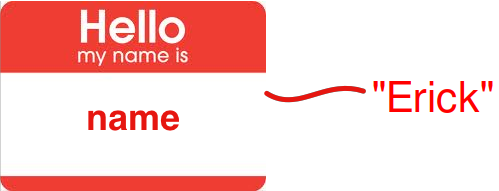
Variables store values under a specified name
VARIABLES

Assigning variables in python
name = "Erick"
gender = "male"
height = 1.73 Types of variables
Variables can store values of different types:
string - a sequence of characters, comprising text
"a", "London", 'X', 'General Assembly'int - an integer, or whole number
1, 5, 9999, -7float - a floating point number (using a decimal point)
3.14, 1.68, 1.0bool - boolean; binary true or false values
True, FalseChanging types
'Casting' a variable to another type
int("42")
float("1.69")
str(1.5) Exercise
Choose 4 things in this room and create variables of 4 different types based on them
Operators
You can process the values in your variables by operators :
| = | Assignment: assign a value to a variable |
| == | Comparison: are two variables equal? |
| != | Comparison: are two variables not equal? |
|
<, >, <=, >= |
Less-than, greater-than, less or equal, greater or equal |
| +, -, *, / | Mathematical operators |
| and, or | Logical operators |
Specific behaviour depends on data type
>>> start = "Lon"
>>> start
'Lon'
>>> end = "don"
>>> start + end
'London'
>>> start + start + end
'LonLondon'
>>> town = 3 * start + end
>>> town
'LonLonLondon'>>> 1 + 1
2
>>> cats = 2
>>> cats
2
>>> dogs = 3
>>> cats == dogs
False
>>> cats < dogs
True
>>> dogs + 1
4
>>> dogs
3
>>> dogs = dogs + 1
>>> dogs
4
>>> pets = cats + dogs
>>> pets
6Questions?
Exercise
Create two string variables :
first for your first name and last for your last name.
Can you make your full name by combining first and last?
Bonus:
What happens if we compare first and last with the ‘<' and ‘>' operators?
Why?
(Cheating encouraged)
Extra exercises
https://www.w3resource.com/python-exercises/python-basic-exercises.phpCollections
Collections of Values
Values can also be stored in a collection :List
Dictionary
Lists
We can store multiple values in a list:
>>> l = [1,3,9,4,884328881]
>>> n = ['first', 'second', 'third', 'fourth']
>>> m = l + n
>>> m
[1, 3, 9, 4, 884328881, 'first', 'second', 'third', 'fourth']A list is a ordered sequence of items (between [...]) each with their own index:
>>> m[0]
1
>>> m[8]
'fourth' Indices

Cool things you can do with lists
>>> l = list(range(10))
>>> l
[0, 1, 2, 3, 4, 5, 6, 7, 8, 9]
>>> l[1:5]
[1, 2, 3, 4]
>>> l[:5]
[0, 1, 2, 3, 4]
>>> del l[5:]
>>> l
[0, 1, 2, 3, 4]
>>> l.append(5)
>>> l
[0, 1, 2, 3, 4, 5]
>>> l.reverse()
>>> l
[5, 4, 3, 2, 1, 0]
>>> 5 in l
True
Bonus
Lists are sequences, and so are strings>>> s = "General Assembly"
>>> s[0]
'G'
>>> s[:7]
'General' Dictionaries
Dictionaries store key: value pairs associatively.>>> personX = {'first':'Erick', 'last':'Ratamero', 'twitter':'@erickratamero'}
>>> personX['first']
'Erick'
>>> personX['age'] = 32
>>> personX
{'twitter': '@erickratamero', 'last': 'Ratamero', 'age': 32, 'first': 'Erick'}
>>> for i in personX.items():
... print(i)
...
('first', 'Erick')
('last', 'Ratamero')
('twitter', '@erickratamero')
some things you can do with Dictionaries
>>> list(personX.keys())
['twitter', 'last', 'first']
>>> list(personX.values())
['@erickratamero', 'Ratamero', 'Erick']Questions?
Exercise
Create a dictionary to represent yourself (or someone else) with some attributes (e.g. hometown, favourite film, height)Bonus:
Add a list of interests to the dictionary. What do you use as key, what do you use as value? (Cheating encouraged)Extra exercises
https://www.w3resource.com/python-exercises/list/https://www.w3resource.com/python-exercises/dictionary/
Putting the pieces together
Loops
For Loops
You use loops to repeat a statement.
A for-loop is useful when you know how many times you want to repeat an action (e.g. for every item in a list)
for item in sequence:
do something with itemMind the Indentation
For Loops
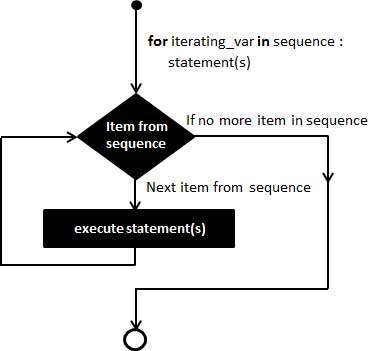
For Loops
for example:
>>> ages = [18, 21, 16, 12]
>>> for age in ages:
.... print(age)
....
18
21
16
12 Visualise this code in action
While Loops
A while-loop is useful when you don’t know when you want to stop looping yet.
A while-loop statement checks a condition and loops until the condition is no longer satisfied.
while condition true:
do somethingWhile loops
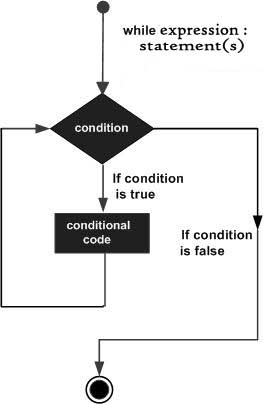
While Loops
for example:
>>> gas = 42
>>> while gas > 0:
... print("Vroom!")
... gas = gas - 10
...
Vroom!
Vroom!
Vroom!
Vroom!
Vroom! Exercise
Write a program that prints all even numbers between 0 and 50
Write a program that prints the first 10 odd numbers
(Cheating encouraged)Conditional Statements
Conditional statements
Conditional statements enable you to deal with multiple options.
A part of your code is executed based on the truth value of a condition. You perform conditional checks with: if, elif, else
if condition:
action
elif other condition: #optional
other action
else:
final action>>> age = 17
>>> if age < 18:
... print("no drinks for you")
...
no drinks for youconditional statements
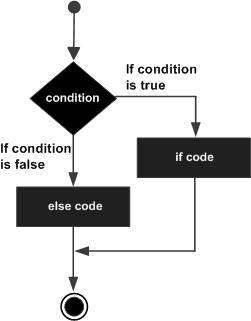
Conditional statements
>>> ages = [18, 21, 16, 12]
>>> for age in ages:
... if age >= 18:
... print("come on in")
... elif age >= 16:
print("not quite yet")
else:
... print("get outta here")
...
come on in
come on in
not quite yet
get outta hereExercise
Write a program to find all numbers which are divisible by 7 and multiple of 5, between 1500 and 2700
Write a program that prints all the numbers from 0 to 6 except 3 and 6.
(Cheating encouraged)Extra exercises
https://www.w3resource.com/python-exercises/python-conditional-statements-and-loop-exercises.phpFunctions
Functions
Functions perform a collections of tasks, bundled under a specific name
Take input argument(s), execute statement(s), return output
Input and output can be of all different types
>>> name = "Erick Ratamero"
>>> length = len(name)
>>> length
18
>>> type(length)
<type 'int'> Built in functions
Functions
You can define your own functions like this:
def function_name(argument(s)):
action with argument(s)>>> def multiply(a, b):
... return a * b
...
>>> multiply(3,4)
12
>>> def greet(name):
... print("hello "+ name)
...
>>> greet('Erick')
>hello ErickQuestions?
Exercise
Write a function with an appropriate name that:
- takes as input a person (represented as dictionary)
- prints out information about the person
(Cheating encouraged)
Extra exercises
https://www.w3resource.com/python-exercises/python-functions-exercises.phpWriting complete structures
Modules
A module is a package of code that extends the native functionality of Python.Use modules to:
- plot graphs
- download web pages
- read and write .csv files
- anything else someone else has already written
Importing a modules into your script is simple:
>>> import random
>>> random.randint(0,10)
0
>>> random.randint(0,10)
9
>>> random.randint(0,10)
3When necessary, we will use Thonny to install extra modules
Scripts
You can also write your code conveniently in a file using your favourite text editor
Such a file is a program or script and can look as simple as this:
print("Hello World") Save your script as “[a_descriptive_name].py”
Navigate in terminal to the location of your file
Run “python [a_descriptive_name].py” either on command line or inside a program that does that for you (we will use Thonny)
Scripts
# this is a comment, use them!
'''
Comments can also
span multiple lines
'''
# print() is a very useful function
# mind the quotes
print("Hello World")
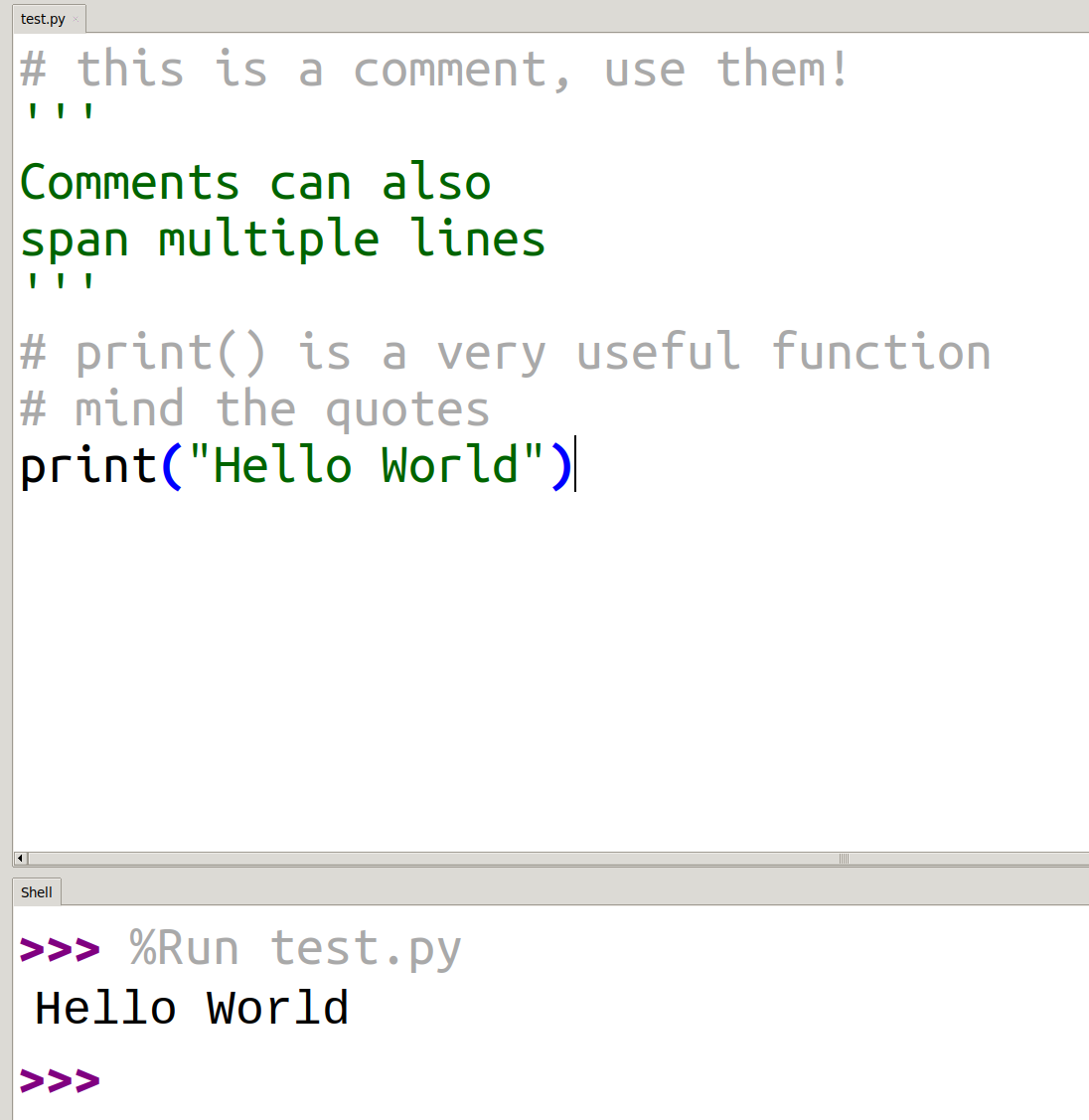
Questions?
Exercise
Implement a function in a script, run it to let it print output
(Cheating encouraged)Useful Resources
google “python” + your problem / question (not a joke)
python.org/doc/; official python documentation, useful to find which functions are available
stackoverflow.com; huge gamified help forum with discussions on all sorts of programming questions, answers are ranked by community
codecademy.com/tracks/python; interactive exercises that teach you coding by doing
wiki.python.org/moin/BeginnersGuide/Programmers; tools, lessons and tutorials
